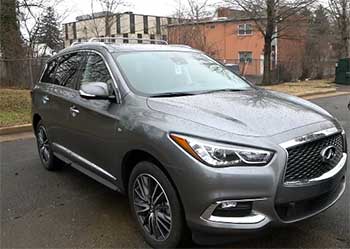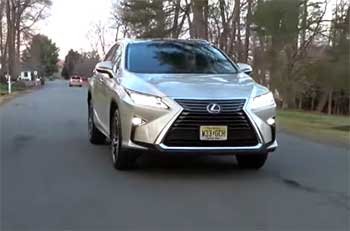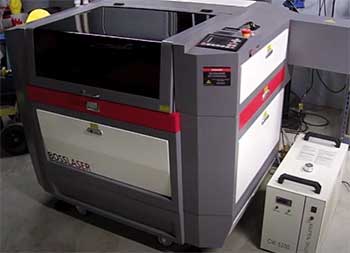I’ve always been drawn to the allure of luxury SUVs—vehicles that promise comfort, style, and practicality wrapped in a sleek package. When I set out to compare the 2025 Infiniti QX60 and the 2025 Lexus RX 350, my goal was to uncover which one truly delivers for families, professionals, or anyone craving a refined ride.
This article is my firsthand exploration of these two midsize luxury SUVs, weighing their pros and cons, key features, and real-world appeal to help you decide which one fits your life best.

Comparison Table: Infiniti QX60 vs. Lexus RX 350
| Feature | Infiniti QX60 | Lexus RX 350 |
| Starting MSRP | $51,550 | $50,475 |
| Engine | 3.5L V6 (295 hp, 270 lb-ft torque) | 2.4L Turbo 4-cylinder (275 hp, 317 lb-ft torque) |
| Transmission | 9-speed automatic | 8-speed automatic |
| Fuel Economy (City/Hwy/Combined) | 22/27/24 MPG (FWD) | 22/29/25 MPG (FWD) |
| Towing Capacity | Up to 6,000 lbs | Up to 3,500 lbs |
| Seating Capacity | 7 (3 rows) | 5 (2 rows) |
| Cargo Space (Behind 3rd/2nd Row/Max) | 14.5 cu ft / 41.6 cu ft / 75.4 cu ft | 16.0 cu ft / 29.6 cu ft / 46.2 cu ft |
| Infotainment Display | 12.3-inch touchscreen | 9.8-inch (standard), 14-inch (optional) |
| Standard Safety Features | ProPILOT Assist, Predictive Forward Collision Warning | Lexus Safety System+ 3.0, Lane Tracing Assist |
| Warranty | 4-yr/60,000-mile basic, 6-yr/70,000-mile powertrain | 4-yr/50,000-mile basic, 6-yr/70,000-mile powertrain |
My Journey with Luxury SUVs
I’ve always been drawn to luxury SUVs for their blend of comfort and capability. The Infiniti QX60 and Lexus RX 350 caught my eye during my search for a vehicle that balances family-friendly features with premium flair. After test-driving both, I realized their differences could sway anyone’s decision, prompting me to share my findings to guide your choice.
I spent days behind the wheel of both, weaving through city traffic, cruising highways, and even towing a small trailer with the QX60. Insights from owner forums on X and expert reviews from MotorTrend, Edmunds, and Kelley Blue Book shaped my perspective, ensuring a well-rounded comparison. Here’s how these SUVs stack up, from design to driving feel.
Design and Style: First Impressions Matter
Infiniti QX60: Elegant and Family-Friendly

The 2025 Infiniti QX60’s exterior is a blend of elegance and modernity. Its double-arch grille and origami-inspired mesh detailing, praised by Edmunds for their sophisticated flair, caught my eye immediately.
The sleek roofline and 20-inch wheels give it a confident yet approachable stance. At 198.2 inches long and 77.9 inches wide, it has a commanding presence.
Inside, the QX60 feels like a sanctuary. The three-row layout, with premium leather and ambient lighting, creates a welcoming vibe for families. The Sensory trim’s massaging front seats were a game-changer on long drives, making my commute feel like a luxury retreat.
Lexus RX 350: Sharp and Sporty

The Lexus RX 350’s design is bold and assertive, with a prominent spindle grille and angular lines that MotorTrend calls “aggressively stylish.” Its 20-inch alloy wheels and sleek LED headlights add a premium edge.
It’s a head-turner, perfect for those who want to stand out. At 192.5 inches long and 75.6 inches wide, it’s more compact.
The RX 350’s interior is driver-centric, with a sleek dashboard and semi-aniline leather seats on higher trims.
The two-row setup feels intimate but limits versatility compared to the QX60. The optional 14-inch touchscreen adds a modern touch, though the standard 9.8-inch screen feels less impressive.
QX60 Design Pros
- Timeless exterior: Sleek grille, elegant lines age gracefully.
- Spacious interior: Three-row layout ideal for families.
- Premium features: Massaging seats, panoramic moonroof elevate comfort.
QX60 Design Cons
- Wider body: 77.9 inches complicates tight parking.
- Understated styling: Less sporty than RX 350’s bold look.
RX 350 Design Pros
- Bold exterior: Spindle grille, angular lines stand out.
- Driver-focused cockpit: Intuitive controls enhance usability.
- Modern tech aesthetic: Optional 14-inch touchscreen impresses.
RX 350 Design Cons
- Two-row limitation: Less versatile for larger families.
- Polarizing styling: Sharp design may not suit all tastes.
Performance: Power Meets Practicality
Infiniti QX60: Smooth and Versatile
The QX60’s 3.5-liter V6, producing 295 horsepower and 270 pound-feet of torque, delivered a composed ride during my tests. Its nine-speed automatic shifted smoothly, and the suspension soaked up highway bumps with ease, per Car and Driver. The Intelligent All-Wheel Drive system provided confidence on wet roads, seamlessly adjusting to conditions.
Hitting 0-60 mph in about 7.5 seconds, the QX60 is respectable for a three-row SUV. Its 6,000-pound towing capacity handled a small trailer effortlessly, making it ideal for family adventures. Fuel economy of 22/27/24 MPG (FWD) and an 18.5-gallon tank offer a 468-mile range, solid for long trips. The QX60 typically recommends premium unleaded fuel.
Lexus RX 350: Sporty and Efficient
The RX 350’s 2.4-liter turbo four-cylinder, with 275 horsepower and 317 pound-feet of torque, felt lively, especially off the line. Its eight-speed automatic and sport-tuned suspension made twisty roads a blast, though the ride was firm over potholes. The 0-60 mph time of 7.6 seconds (FWD) or 7.2 seconds (AWD) is competitive.
Fuel economy edges out at 22/29/25 MPG (FWD), and the RX 350h hybrid option boosts it to 36 MPG combined, a big draw for efficiency seekers. The 3,500-pound towing capacity limits it to smaller loads, and the 17.8-gallon tank provides a 427-mile range. The RX 350 feels sportier but less versatile than the QX60. It runs on regular unleaded gasoline.
QX60 Performance Pros
- Robust towing: 6,000 lbs for trailers, boats.
- Smooth ride: Suspension excels on highways.
- Intelligent AWD: Enhances grip in tough conditions.
QX60 Performance Cons
- Lower torque: 270 lb-ft vs. RX 350’s 317 lb-ft.
- No hybrid option: Misses RX 350h’s efficiency.
- Recommends premium fuel.
RX 350 Performance Pros
- High torque: 317 lb-ft for quick acceleration.
- Hybrid efficiency: RX 350h reaches 36 MPG combined.
- Sporty handling: Agile on winding roads.
RX 350 Performance Cons
- Lower towing capacity: 3,500 lbs limits utility.
- Firm ride: Sporty suspension harsh on rough roads.
Interior and Comfort: Where Luxury Lives
Infiniti QX60: Spacious and Family-Oriented
The QX60’s three-row interior is a family haven, offering 42.1 inches of front legroom and 37.7 inches in the second row, per Kelley Blue Book. The third row’s 31.6 inches of legroom suits kids better than adults, but it’s a lifesaver for larger groups. Cargo space starts at 14.5 cubic feet behind the third row, expanding to 41.6 cubic feet behind the second row, and 75.4 cubic feet with all seats folded.
The panoramic moonroof and 17-speaker Bose system (Sensory trim) elevated my road trips, creating a premium vibe. Sliding second-row seats made third-row access easy, even with a child seat installed. The base trim’s leatherette seats, however, feel less upscale than higher trims’ leather.
Lexus RX 350: Intimate and Premium
The RX 350’s two-row setup prioritizes comfort, with 41.1 inches of front legroom and 38.0 inches in the rear. Cargo space starts at 29.6 cubic feet behind the second row, which is comparable to the QX60’s space behind its second row, expanding to 46.2 cubic feet with seats folded. Heated and ventilated seats (Premium Plus trim) add luxury, and the optional Mark Levinson 21-speaker system delivers crisp audio.
The RX 350’s driver-centric layout is intuitive, with controls within easy reach. The lack of a third row limits its family appeal, but the premium materials, like semi-aniline leather, feel a touch more refined than the QX60’s base trim. It’s ideal for smaller households seeking a cozy cabin.
QX60 Interior Pros:
- Three-row seating: Up to seven passengers for families.
- Generous cargo: 75.4 cu.ft. max for gear-heavy trips.
- Luxe features: Massaging seats, Bose audio enhance comfort.
QX60 Interior Cons:
- Cramped third row: Limited legroom for adults.
- Base trim materials: Leatherette less premium than leather.
RX 350 Interior Pros:
- Spacious two rows: Comfortable for front and rear passengers.
- Premium materials: Semi-aniline leather, Mark Levinson audio.
- Driver-centric design: Intuitive controls enhance usability.
RX 350 Interior Cons:
- No third row: Limits family versatility.
- Less cargo behind seats: 29.6 cu.ft. vs. QX60’s 41.6 cu.ft. (behind 2nd row).
Technology and Infotainment: Staying Connected
Infiniti QX60: Modern and Intuitive
The QX60’s 12.3-inch touchscreen, with wireless Apple CarPlay and wired Android Auto, impressed me with its crisp graphics and responsiveness. Five USB ports (with an additional charging port on higher trims), a wireless charger, and an optional head-up display kept me connected, while the ProPILOT Assist with Navi-link anticipated curves for smooth highway drives. The system can feel overly cautious in heavy traffic, occasionally over-correcting.
The 17-speaker Bose system (Sensory trim) filled the cabin with rich sound, perfect for my playlists. The surround-view camera eased parking in tight spots, a boon for the QX60’s wider body. The wired Android Auto requirement, however, feels dated compared to fully wireless systems.
Lexus RX 350: Sleek but Limited
The RX 350’s 9.8-inch touchscreen (14-inch optional) supports wireless Apple CarPlay and Android Auto, with the Lexus Interface system earning praise from Edmunds for its intuitiveness. The optional Mark Levinson 21-speaker system matched the QX60’s audio quality but comes at a premium. The Lexus Safety System+ 3.0, with adaptive cruise control and Lane Tracing Assist, performed well but lacks the QX60’s predictive navigation tech.
Wireless charging and multiple USB ports are standard, but the smaller 9.8-inch screen feels underwhelming compared to the QX60’s. The hybrid trims add eco-focused tech, like efficiency displays, which appeal to green drivers. Advanced features, like the 14-inch screen, are reserved for higher trims, limiting base-model appeal.
QX60 Technology Pros:
- Larger standard touchscreen: 12.3 inches, responsive interface.
- Advanced driver aids: ProPILOT Assist with Navi-link shines.
- More standard tech: Head-up display, Bose audio included on some trims.
QX60 Technology Cons:
- Wired Android Auto: Lags behind wireless competitors.
- Overly sensitive aids: ProPILOT can intrude in traffic.
RX 350 Technology Pros:
- Intuitive interface: Lexus Interface is user-friendly.
- Premium audio option: Mark Levinson system delivers.
- Hybrid tech: RX 350h adds eco-focused features.
RX 350 Technology Cons:
- Smaller standard screen: 9.8 inches vs. QX60’s 12.3.
- Feature exclusivity: Advanced tech limited to higher trims.
Safety: Confidence Behind the Wheel
Infiniti QX60: Proactive and Top-Rated
The QX60’s IIHS Top Safety Pick designation (for 2025) and its predicted 5-star NHTSA rating (based on previous model year testing) gave me peace of mind during family test drives. Features like forward emergency braking, blind-spot warning, and rear cross-traffic alert worked seamlessly, with the surround-view camera making parking stress-free. The QX60’s safety suite is comprehensive and reliable, a standout in its class.
Lexus RX 350: Robust and Reliable
The RX 350’s Lexus Safety System+ 3.0 includes Intelligent High Beams, Lane Tracing Assist, and a Pre-Collision System with pedestrian detection. It earned strong IIHS scores (Good ratings in most tests for 2025 model year) and a five-star NHTSA score, though it’s not explicitly listed as a “Top Safety Pick” for 2025 yet. Its adaptive cruise control was smooth, but it lacks the QX60’s predictive navigation features. Both SUVs feature airbags and blind-spot monitoring, but the QX60’s broader standard features give it a slight edge.
QX60 Safety Pros:
- Top safety ratings: IIHS Top Safety Pick, predicted 5-star NHTSA.
- Predictive tech: Anticipates hazards effectively.
- Standard features: Comprehensive aids across all trims.
QX60 Safety Cons:
- Overly cautious aids: Blind Spot Intervention can be intrusive.
- Traffic sensitivity: ProPILOT over-corrects in heavy traffic.
RX 350 Safety Pros:
- Robust safety suite: Lexus Safety System+ 3.0 performs well.
- Intuitive controls: Lane-keeping, cruise control are smooth.
- Strong reliability: Safety systems backed by Lexus reputation.
RX 350 Safety Cons:
- Less predictive tech: Lacks QX60’s navigation-based aids.
- Non-standard features: Advanced aids can be limited to higher trims.
Pricing and Value: What’s Your Budget?
The QX60’s $51,550 starting MSRP is slightly higher than the RX 350’s $50,475, but it includes standard features like a panoramic moonroof and heated seats, per Kelley Blue Book. Its four trims (Pure, Luxe, Sensory, Autograph) offer flexibility, with the Sensory trim (~$58,000) balancing luxury and cost. Used 2022-2023 QX60s range from $35,000-$45,000, though some early models faced transmission issues, per X forums.
The RX 350’s seven trims, including the RX 350h hybrid (starting at ~$52,000), provide variety, but base models lack features standard on the QX60. The hybrid’s 36 MPG combined offers long-term savings, and Lexus’s resale value (estimated 65-70% after five years vs. QX60’s estimated 42.3%) is a plus, per Kelley Blue Book depreciation data. The QX60’s 4-yr/60,000-mile basic warranty outshines the RX 350’s 4-yr/50,000-mile coverage.
QX60 Pricing Pros:
- More standard features: Moonroof, heated seats included.
- Competitive MSRP: $51,550 for three-row versatility.
- Strong towing value: 6,000 lbs enhances utility.
QX60 Pricing Cons:
- Slightly higher price: $51,550 vs. RX 350’s $50,475.
- Premium fuel cost: Adds to running expenses.
RX 350 Pricing Pros:
- Lower starting MSRP: $50,475 undercuts QX60.
- Hybrid savings: RX 350h boosts efficiency.
- Strong resale value: Retains an estimated 65-70% after five years.
RX 350 Pricing Cons:
- Fewer base features: Moonroof, advanced tech not always standard.
- Pricier higher trims: Premium Plus, Luxury cost more.
Driving Experience: Real-World Impressions
The QX60’s smooth ride and quiet cabin made my daily commute a breeze. Its nine-speed transmission shifted seamlessly, and the AWD system handled a rainy day with confidence, though its 198.2-inch length and 38.1 ft turning circle required care in tight lots. The V6’s power was ample for highway merging, but it lacked the RX 350’s low-end punch.
The RX 350’s sportier suspension and torque-heavy turbo engine shone on winding roads, offering agile handling. The ride was firmer over bumps, and the hybrid option smoothed out city driving. Its smaller 192.5-inch length and ~37.4 ft turning circle made parking easier, but the lack of a third row limited its family appeal.
Also Read: Jeep Liberty vs. Jeep Patriot
Reliability: Built to Last?
The RX 350 (2024 model year) earns a “Great” J.D. Power reliability score (85/100), compared to the QX60 (2022 model year) which is rated “Average” (80/100). Lexus’s complimentary first scheduled maintenance visit (for 6 months/5,000 miles) and reputation for durability are unmatched, per Consumer Reports. The QX60’s 4.2/5 Kelley Blue Book owner rating is strong, but some 2022 models faced transmission complaints on X forums.
Maintenance costs are lower for the RX 350, averaging $550 annually vs. the QX60’s $650, per RepairPal. Both typically recommend premium fuel for optimal performance, though the RX 350 can use regular unleaded. The QX60’s longer warranty offers extra peace of mind for families.
Lifestyle Fit: Who Are These SUVs For?
The QX60 is a family’s dream, with three-row seating, robust towing, and safety for school runs or road trips. Its spacious cabin and cargo flexibility suit gear-heavy adventures. I pictured it loaded with kids and camping gear, ready for a weekend getaway.
The RX 350 targets singles, couples, or small families who value efficiency and sporty handling. The hybrid option appeals to eco-conscious drivers, and its compact size fits urban lifestyles. If you don’t need a third row, the RX 350 delivers premium comfort.
Recent Reviews: What Others Are Saying
MotorTrend praises the QX60’s value and towing but notes its V6 lacks refinement, while the RX 350’s sporty dynamics and hybrid efficiency earn high marks. Edmunds highlights the QX60’s spaciousness and the RX 350’s resale value but flags its limited cargo. X posts commend the QX60’s family-friendly design but mention its fuel costs, while RX 350 owners love its reliability and handling.
Frequently Asked Questions (FAQ)
Which is more reliable, INFINITI or Lexus?
Lexus generally has a slight edge in reliability, scoring 85/100 (RX 350, 2024 model year) vs. the QX60’s 80/100 (2022 model year) in J.D. Power’s reliability ratings. The QX60’s 4-yr/60,000-mile basic warranty offers more coverage than Lexus’s 4-yr/50,000-mile. Both are dependable, but Lexus’s track record is stronger.
What is the Lexus equivalent of INFINITI QX60?
The Lexus TX 350, a three-row SUV starting at ~$55,000, is the closest equivalent to the QX60. The RX 350, with two rows, targets a different audience. The TX 350 offers similar family-focused features and space.
What is the most common problem with Lexus RX 350?
Some owners report issues with the infotainment system, particularly the touchpad controller (in older models), which can feel unresponsive, per X forums and Consumer Reports. Software updates often resolve this. Mechanical issues are minimal.
Which is more expensive to maintain, Lexus or INFINITI?
Lexus typically has lower maintenance costs, averaging $550 annually vs. Infiniti’s $650, per RepairPal. Lexus’s initial complimentary maintenance adds value. The RX 350h hybrid further reduces fuel costs.
Conclusion: Your Road, Your Choice
You’re now equipped to decide between the Infiniti QX60 and Lexus RX 350. If you crave luxury and don’t mind the higher price, the QX60’s upscale interior and towing prowess might win you over. But if you value reliability, affordability, and extra cargo space, the RX 350 is tough to beat. I’d love to hear what you prioritize in an SUV—let me know what sways your decision!

